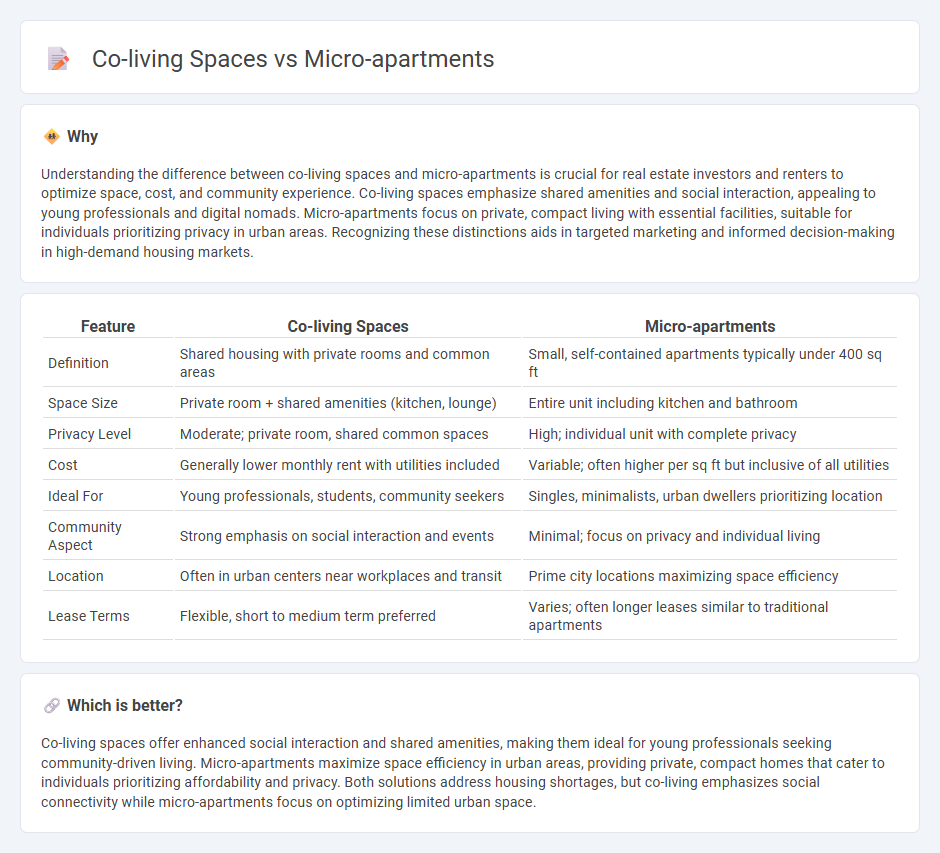
Co-living spaces offer shared amenities and community-focused living environments designed to reduce housing costs and foster social interaction, appealing to young professionals and digital nomads. Micro-apartments provide compact, private units with efficient design, maximizing space in high-demand urban areas and targeting individuals seeking affordable, independent living. Explore detailed comparisons to understand which innovative housing option suits your lifestyle and investment goals best.
Why it is important
Understanding the difference between co-living spaces and micro-apartments is crucial for real estate investors and renters to optimize space, cost, and community experience. Co-living spaces emphasize shared amenities and social interaction, appealing to young professionals and digital nomads. Micro-apartments focus on private, compact living with essential facilities, suitable for individuals prioritizing privacy in urban areas. Recognizing these distinctions aids in targeted marketing and informed decision-making in high-demand housing markets.
Comparison Table
| Feature | Co-living Spaces | Micro-apartments |
|---|---|---|
| Definition | Shared housing with private rooms and common areas | Small, self-contained apartments typically under 400 sq ft |
| Space Size | Private room + shared amenities (kitchen, lounge) | Entire unit including kitchen and bathroom |
| Privacy Level | Moderate; private room, shared common spaces | High; individual unit with complete privacy |
| Cost | Generally lower monthly rent with utilities included | Variable; often higher per sq ft but inclusive of all utilities |
| Ideal For | Young professionals, students, community seekers | Singles, minimalists, urban dwellers prioritizing location |
| Community Aspect | Strong emphasis on social interaction and events | Minimal; focus on privacy and individual living |
| Location | Often in urban centers near workplaces and transit | Prime city locations maximizing space efficiency |
| Lease Terms | Flexible, short to medium term preferred | Varies; often longer leases similar to traditional apartments |
Which is better?
Co-living spaces offer enhanced social interaction and shared amenities, making them ideal for young professionals seeking community-driven living. Micro-apartments maximize space efficiency in urban areas, providing private, compact homes that cater to individuals prioritizing affordability and privacy. Both solutions address housing shortages, but co-living emphasizes social connectivity while micro-apartments focus on optimizing limited urban space.
Connection
Co-living spaces and micro-apartments are interconnected as innovative housing solutions targeting urban dwellers seeking affordability and community engagement within limited square footage. Both concepts emphasize maximizing space efficiency through smart design while fostering social interaction among residents. The rise of co-living and micro-apartment developments addresses urban housing shortages by blending private living quarters with shared amenities.
Key Terms
Space Efficiency
Micro-apartments maximize space efficiency by offering compact, multifunctional living areas typically ranging from 200 to 400 square feet, designed to accommodate essential amenities within a limited footprint. Co-living spaces optimize communal living by combining private bedrooms with shared kitchens, lounges, and workspaces, promoting social interaction while reducing individual living costs. Explore the benefits and design strategies of both models to find the ideal solution for urban space challenges.
Shared Amenities
Micro-apartments maximize individual living space, typically featuring compact, self-contained units with basic amenities designed for privacy and efficiency. Co-living spaces emphasize shared amenities such as communal kitchens, lounges, and workspaces to foster social interaction and reduce living costs. Explore more about how shared amenities impact lifestyle choices in these housing options.
Lease Structure
Micro-apartments typically offer traditional lease structures with fixed terms ranging from six months to one year, providing individual privacy and autonomy for tenants. Co-living spaces often implement flexible lease agreements, including month-to-month options, catering to transient populations and fostering community engagement through shared amenities and common areas. Explore deeper insights into lease structures and tenant benefits in both housing models to make an informed decision.
Source and External Links
Microapartment - Microapartments are small, self-contained living spaces, typically ranging from 150 to 350 square feet, designed for urban living with amenities like a kitchenette and bathroom.
Tiny apartments a big deal in many US cities - Micro-apartments are becoming increasingly prevalent in U.S. cities, with cities like Seattle and Boston seeing significant numbers of these units in new construction to address affordability and density.
'Niche' micro-apartments to feature shapeshifting furniture - A new micro-apartment development in Tampa features units with innovative, shape-shifting furniture to maximize space efficiency and functionality.
 dowidth.com
dowidth.com